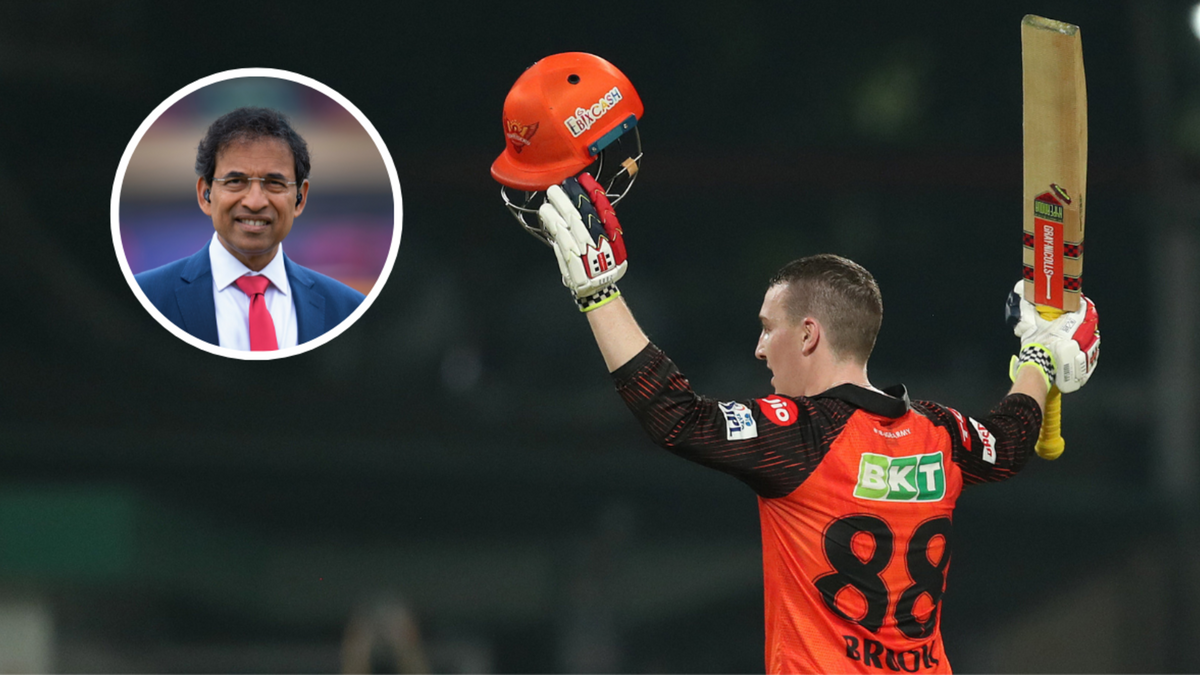
Harry Brook’s maiden IPL century was brilliant because of, not in spite of his approach against spin, writes Ben Gardner.
Today was the day Harry Brook arrived at the Indian Premier League. A record-breaking deal had given way to the inevitable early struggles, a few more quiet knocks and the whispers would become awkward. In the space of two deliveries against Umesh Yadav, all of that faded away. Two wayward balls, two sixes thrash-flayed over the off-side. Brook was away.
Later on, Lockie Ferguson, one of the fastest bowlers in the world, was swatted aside for four fours and a six in an over. A maiden IPL century came up in the final over, off 55 balls. Brook walked off sweaty, exhausted, but elated, and Sunrisers Hyderabad had a mammoth 228-4 to defend.
And yet, in the eyes of some pundits or commentators, Brook didn’t go hard enough. He went boundaryless in the middle-overs and his score of 16 off 19 balls from the end of the powerplay until the start of the 15th over was enough to prompt criticism. “Brook needs to be careful here,” tweeted Harsha Bhogle. “Struggling to get spin away after a blazing start. SR 242 against pace, 95 against spin. Needs to move on.”
This is not a one-off. A leading story in the latter stages of the Pakistan Super League was Simon Doull v Babar Azam, the latter accused of slowing down as he neared a milestone. Virat Kohli came in for similar chastisement. So did Shikhar Dhawan, who had the perfect response after an innings beyond all reproach, and a masterclass in playing the situation: “I hope you were happy with my strike rate”.
The message is clear: there is to be no backward step. There is no time to breathe. It’s not about what you’ve done or what you will do. What are you doing right now to score as quickly as possible, to risk as much as you can?
In some ways, this is a welcome course correction. It’s not long ago that the idea there was such a thing as a match-losing innings was the preserve of an enclave of T20 purists. The number-crunchers would point out the flaws of Kohli or Babar, while the traditionalists would be blinded by the high elbows and the scampered singles. It is genuinely to be welcomed that we’re reaching a point where no cow is sacred, no legend exempt from a barb or two.
But there is a risk here of under-analysis, with a couple of numbers spun out into the one true narrative, and the fascination of T20 cricket lost in the process. In truth, at any one time, there will be a million things going through the head of a batter, and at the other end a bowler doing everything they can to stop them. It’s not simply a game where the batter pushes the pedal down further and further until they careen off the tracks. There are twists and turns, and ample opportunity for steering and applying the brakes. Bowlers are allowed to bowl well. Not every shot has to be an attempt at a six.
So let’s take Brook’s innings, because it’s in that slowdown that its magnificence is revealed. First, there’s the obvious point, but often missed, that the end of a Powerplay naturally quietens things down. There is an extra fielder on the boundary and more singles on offer. That’s the point of it.
But there was something deeper going on here too. In that stretch from over seven to 14, Brook’s 16 off 19 accounted for less than 40 per cent of the balls on offer. Aiden Markram, out in the 13th over, hit 49 off 24 in that time. Brook knew he could take down Kolkata Knight Riders’ quicks, knew he’d struggle against anything slower, and knew his batting partner was ready to smash the spinners out of the Kotla. Despite his apparent sluggishness, Sunrisers Hyderabad’s run rate dipped by only a run from the end of the powerplay to the return of pace. And Brook made sure he was there to cash in when the tweakers’ allocation ran out. Had he listened to those encouraging him to go harder, faster, better and stronger, he would likely have been out before then. His eventual split read 34 off 29 against spin, and 66 off 26 against pace.
For a young batter anointed as a future all-format great, in their first season in the Big Circus, the temptation to take your first big start and run with it must be hard to deny. Instead, Brook showed why he’s so special. It’s not just the technique, the array of shots impossible for any other player. It’s the brain to decide which is the best at any one time, the humility to realise that, sometimes, the tuck for a single really is the percentage option, and the maturity to deal with the queries such an approach can bring.
Brook showed exactly why he is the future of T20 cricket, because he doesn’t just play the game; he understands it.








